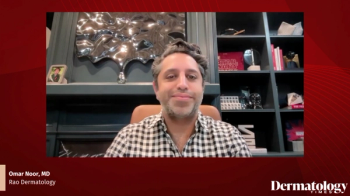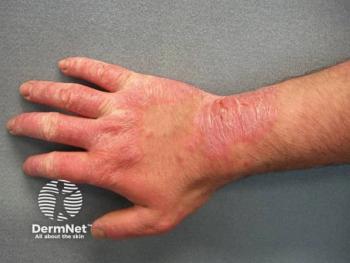
Optimizing CHE Care: Evolving Strategies for Diagnosis and Management
Key Takeaways
- CHE's multifactorial nature requires a nuanced, patient-centered approach for effective management and diagnosis.
- Emerging therapies like delgocitinib target cytokine-mediated pathways, offering rapid symptom relief and improved outcomes.
Explore innovative strategies for managing chronic hand eczema, focusing on personalized care, early treatment, and understanding complex subtypes for better outcomes.
Chronic hand eczema (CHE) remains one of the most prevalent and challenging dermatologic conditions, given its multifactorial etiology and significant impact on patients' quality of life. In recent advances, a shift toward more flexible, patient-focused management strategies is gaining traction, emphasizing early targeted treatments and sensible use of diagnostics.
A recent graduate-level review by Sophia A. Mense, Sawyeh Maher, and Raj Chovatiya, MD, PhD, MSCI, FAAD, provides a comprehensive framework for clinicians navigating this complex condition amid evolving therapeutic options.1 Chovatiya, clinical associate professor at the Rosalind Franklin University Chicago Medical School, founder and director of the Center for Medical Dermatology and Immunology Research in Chicago, Illinois, and a Dermatology Times Editorial Advisory Board member, spoke about the recent findings.
“CHE may seem like unfamiliar territory to some of us, given that much of the early work in this disease state focused on its occupational burden outside the United States, but a steady stream of research over the past decade has highlighted just how common and impairing this condition truly is,” he said. “In our work, we sought to critically examine available data and pose a practical approach to CHE that emphasizes clinical judgment and common sense to better help our patients.”
Drawing on insights from this review, we explore 5 principles that can help clinicians optimize care for CHE in real-world settings.
Understanding the Multifaceted Complexity of CHE
CHE is a complex interplay of subtypes, including allergic contact dermatitis (ACD), irritant contact dermatitis, and atopic hand eczema.2 These subtypes often coexist within the same patient, leading to a challenging diagnostic landscape. Standard treatments, such as topical therapies, often fall short when underlying triggers or allergens are not identified or addressed. This complexity underscores the importance of a nuanced, patient-centered approach.
“CHE is a multifactorial, heterogeneous inflammatory disease that affects primarily the hands and wrists and consists of multiple overlapping morphologic and etiologic subtypes. This complex clinical and pathogenic picture necessitates a streamlined and up-to-date approach to disease diagnosis and management, especially with new and emerging therapies like delgocitinib cream,” Chovatiya added.
Rethinking the Role of Patch Testing
Traditionally, universal patch testing has been regarded as the gold standard for diagnosing ACD. However, the review highlights its limitations, including issues such as allergen availability, patient discomfort, and the time required for results, which can sometimes delay treatment. Although patch testing can uncover hidden allergens and guide avoidance strategies, routine patch testing for patients with CHE may not always be feasible or beneficial.
Instead, the authors advocate for a targeted, patient-centered approach. They recommend considering patch testing in cases with clear exposure histories, such as occupational contact with metals, fragrances, or chemicals, or in refractory cases unresponsive to standard therapies. A tailored approach ensures that testing adds value and improves outcomes without delaying effective treatment.
Prioritizing Early and Aggressive Therapies
One of the most significant advances in disease management is the development of targeted therapies like delgocitinib (LEO Pharma), a topical Janus kinase inhibitor. These emerging treatments can directly address the cytokine-mediated pathways involved in CHE’s immunopathogenesis, providing rapid and effective symptom relief. Initiating these therapies promptly can significantly mitigate inflammation, reduce chronicity, and improve patient outcomes, balancing safety and efficacy. According to the authors, this approach also ensures that patients are not left untreated while waiting for patch test outcomes, which is a critical consideration for real-world practice.
Balancing Diagnostic Thoroughness and Practicality
Although diagnostic tools like patch testing are essential, they should not compromise timely patient care. Providers should use clinical judgment to weigh the benefits of allergen identification against the urgency of symptom control. The authors encourage dermatologists to initiate prompt treatment based on the severity and suspected etiology and then reassess response over time. In many cases, the immediate use of newer therapies and management can provide relief and prevent disease progression. If symptoms worsen, however, patch testing can then be used to refine treatment. With this flexible and pragmatic approach, clinicians can prevent treatment delays and minimize patient frustration.
Implementing a Patient-Centered Management Plan
Finally, effective CHE management relies on adopting a personalized approach involving patient education about potential triggers, skin care routines, and lifestyle modifications. The authors emphasize an individualized and comprehensive plan, considering patient preferences, occupational exposures, and disease severity. Additionally, recognizing socioeconomic and real-world barriers, such as access to testing or allergen avoidance, further emphasizes the importance of personalized strategies. Tailoring therapy and setting realistic expectations not only improves adherence but also empowers patients to participate actively in their care.
References
1. Mense SA, Maher S, Chovatiya R. A practical approach to chronic hand eczema. Dermatol Ther (Heidelb). 2025;15(7):1953-1971. doi:10.1007/s13555-025-01433-y
2. Zappia E, Macagno N, Quaglino P, Roccuzzo G, Ribero S. Hand eczema: a review of clinical, dermoscopic and histological features. Ital J Dermatol Venerol. 2024;159(5):521-529. doi:10.23736/S2784-8671.24.07879-4
Newsletter
Like what you’re reading? Subscribe to Dermatology Times for weekly updates on therapies, innovations, and real-world practice tips.



















